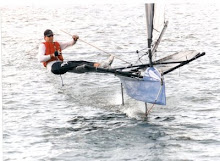

After reading Adam and Katherine's stories about the Opti project, I got to thinking about adapting my wife's boat to foils. Susan has been sailing
Aftermath for about ten years and is interested in trying a foiler. So over the next few weeks I'll be modifying moth #2681 so Susan could try the foils at the Classic Moth Mid-winters over Super Bowl weekend.
According to George Albaugh, the historian of the
Classic Moth Boat Association, John Shelley's Mk I design was built on the Isle of Wight by William McCutcheon and imported to the States in 1964 by Al Menz for his son Chipper. Chipper sailed out of the Greater Wildwood Yacht Club in South Jersey and competed for a few years, including in the '65 Worlds held at Cape May, NJ, where he finished 14th out of 35 boats (his best finish was a 2nd in the 6th race of the regatta.) George recalls that Shelley's design created a stir among the moth fleet since it was one of the first boats that, in the right hands and conditions, could plane to weather. After a few successful years, like many boats of her era, #2681 eventually was stored in a garage and neglected. When George found her in 1998 and turned the boat over to me for a rehab, I got just the hull. The rig and blades had somehow disappeared over the previous 30 years.
My intention was to not restore the boat to the original condition, but to make it user-friendly for Susan to sail. The overall vision was to keep the hull panels and shape intact, but to remove the bulkheads and daggerboard well to allow a complete re-decking with roll tanks and a small footwell, making the boat self-rescuing. I also wanted to raise the boom height so I needed to install a foredeck with a good bit of camber (the classic moth rules at the time had a 12" maximum height of boom above the deck.) Since the Shelley also had a rather blunt bow, I decided to remove the bow piece, pull the hull panels together at the stem and raise the sheer forward by seven inches.


The project was fun, even if it looks rather strange. I decided to paint the original hull panels white with the raised sheer black. The deck and tanks are finished bright. The new name "Aftermath" is a play on words in my job as a math teacher and the result of the rather extensive conversion. Susan, while rather non-competitive, enjoys the result claiming her boat is the dryest in the fleet. While Susan usually finishes mid-fleet,
Aftermath has proved sucessful in competition - I sailed the Shelley to a second place in the 2008 national championship.


So, how will the conversion to a foiler go? Stay tuned over the next few weeks and see. Our midwinters are going to be held in Gulfport, Florida on February 6 and 7. I plan on sailing my mistral
Try-Umph in regular floating mode and Susan hopes to fly
Aftermath. If successful not only will she become the oldest "bird" to fly (having turned 52 this December,) she will also have the world's oldest foiling moth (the Shelley will be 45 years old.)









